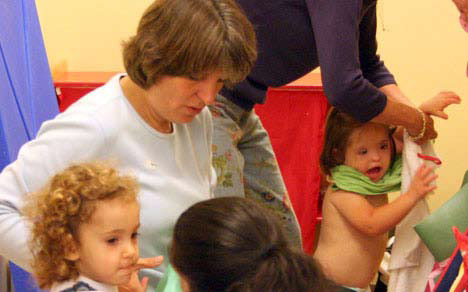
Learning to get dressed can be a difficult task for many children. As a parent, teacher or early childhood professional, your job is to teach new skills that will help your child build independence and move forward in her development. You also teach new skills to reduce frustration, promote self-esteem, and to replace behaviour that may not be the most acceptable.
Here’s as example:
Chung Lee has difficulty putting on her jacket. When trying to get dressed for outdoor play, she throws her jacket to the floor and screams. Chung Lee is using problem behaviour to tell us, “This is too hard! I need some help”. If you have a child like Chung Lee, you too can teach her to independently put on a jacket – step by step.
Breaking Down the Task
Though some children quickly learn skills through observing and imitating others, many need the new skill to be broken down into smaller steps and to be allowed time to master each step in the sequence. The breaking down of complex skills into smaller components is called task analysis. Anything we do can be broken down into smaller steps. The number of steps depends on the needs of your child.
There are various ways to put on a jacket including the “Flip Flop” method where your child is taught to flip the jacket over their head and onto their shoulders, etc. This method is fine, but remember to choose one that works best for you and your child. Consider that some children may have difficulty learning a whole new method later on.
In our example, we decide to teach Chung Lee to put on her jacket in a way that is similar to how her parents and teachers put it on her. Many of these steps are familiar to Chung Lee and we can teach her to do them independently.
Let’s break down the steps to putting on a jacket:
- Take jacket off the hook.
- Hold jacket with left hand.
- Slip right arm up through right arm hole.
- Pull jacket up onto right shoulder.
- Reach left arm behind your back.
- Push left arm through the left arm hole.
- Place both hands on the collar and pull forward to adjust the jacket.
- Zip up the jacket.
In this case, “zipping” up the jacket involves another set of very complex steps but we’ll focus on putting the jacket on for now.
Teaching the New Skill
When teaching a self-help skill, consider using visuals such as photos or pictures symbols that represent each step. Place them in order on a board and post them in the area your child usually puts on her jacket, such as the front hallway or cubby. Use this visual tool to introduce the skill and refer to the steps every time your child puts has to put on her jacket.
In order for your child to learn the steps to a new skill, you will have to provide assistance or “prompt” along the way. A prompt is a cue or hint meant to help your child to perform a desired behaviour, skill, or part of a skill.
Start by providing hand-over-hand assistance with each step to get your child familiar with this routine. Gradually, provide less assistance, as she masters each step. This process is called fading – it involves reducing the need, strength or level of the prompt. For example, you can reduce the amount of physical prompting from hand-over-hand to partial physical prompting by touching her elbow to start off a movement, and then by modelling the actions as you put on your own jacket.
Giving Reinforcement
Reinforcement is anything that motivates or encourages a child. It is any environmental event that maintains or strengthens an action or behaviour. Praise, a special activity, music, toys and food can be used as reinforcers. Reinforcement is a reward that occurs or is given after a behaviour.
It is important to motivate and reward your child who is learning a new skill. It helps them to stay on track and understand what is required or expected of them. By rewarding your child for approximating or getting increasingly closer to the steps that we want to see in the end we can shape her behaviour.
In our example, we can reinforce Chung Lee for following each step by giving her verbal praise and letting her go quickly to outdoor play. Remember that verbal praise needs to describe the positive behaviour. Instead of just saying “Good job!” you can say, “Hooray! You put your jacket on!” As Chung Lee gets more comfortable with performing each step, gradually reduce the amount of reinforcement.
Generalizing the New Skill
You will what your child to know that this new skill can be applied in many places, with many people, and under many conditions. For some children, learning to dress themselves at the child care centre does not necessarily mean that they are going to demonstrate this skill at home, or with anyone other than the person who taught them.
To help Chung Lee generalize this skill we can:
- Use similar but different jackets to teach the same skills (e.g., winter jacket, spring jacket, cardigan).
- Have others teach the same skills.
- Teach the skill in several different locations around the child care centre and at home (e.g., add a jacket or cardigan to the dramatic centre as part of the dress-up clothing).
